Bats are important in controlling insects and pollinating. They are social, living in groups, sometimes hundreds at a time. Bats are amazing mammals from the Microchiroptera family.
The majority of bats live on insects, including moths, cockroaches, beetles, and mosquitoes. The smallest of bats can eat up to five hundred insects in an hour, which means a colony can eat up to the weight of two blue whales in one night.
Table of Contents
Interesting Facts about Bats
Before looking into the different types of bats there are in the world, have a look at some of the interesting facts about these mammals.
- Bats are the only flying mammal. Flying squirrels do not fly, they glide, where the bat sustains flight.
- Not all bats are nocturnal. While the majority of bats do hunt at night, some hunt early in the evening or at dawn.
- Bats range in size, some are so small, weighing only 2 grams. The hog-nosed bat is not only small, it is the smallest mammal in the world.
- They are not the same as birds. Their wings are different, there are no feathers, and are made up f fingers.
- They have an overpowered cardiovascular system, giving them the additional power they need to fly. Their hearts must also help keep blood circulating when they roost upside down.
- Bats don’t flap their wings like birds, they almost swim through the air, using a flap and guide technique, which has proven very effective.
- They can eat a lot of bugs and be beneficial in reducing insects in or around the home.
- Farmers encourage bats, as they can use fewer pesticides on their crops, saving time and money.
- Bats don’t enjoy winter and they will either hibernate or migrate to the south during the cold months.
- Their hearts can beat anywhere from four beats per minute, during hibernation to more than one thousand beats per minute, when flying for an extended period.
- They are designed to hang upside down. Hanging upside down reduces the risk of predators locating and reaching them.
- Hanging upside down gives the bat enough speed when they are ready to fly, they simply drop and fly. Their back legs are small and are not enough to get speed to take off. They have to drop down in order to get started with the flight.
- Most of the time you won’t notice bats, because they are out hunting at night, but they are the second most populous mammal species in the world. Rodents are the first. There are more than one thousand three hundred species of bats in the world.
- Bats are food for hawks, eagles, owls, raccoons, snakes, and even humans
- Some are considered endangered due to their habitats being destroyed
- Not all bats are blind, some have excellent vision. Those with poor sight rely on an echo call, known as echolocation, which helps them identify prey and obstacles.
- Yes some bats drink blood, but it is animal blood and not human blood
- Some bats eat fruit or feed on nectar
- They can live in large colonies of hundreds or thousands of bats
Types Of Bats
1. Old World Fruit Bats
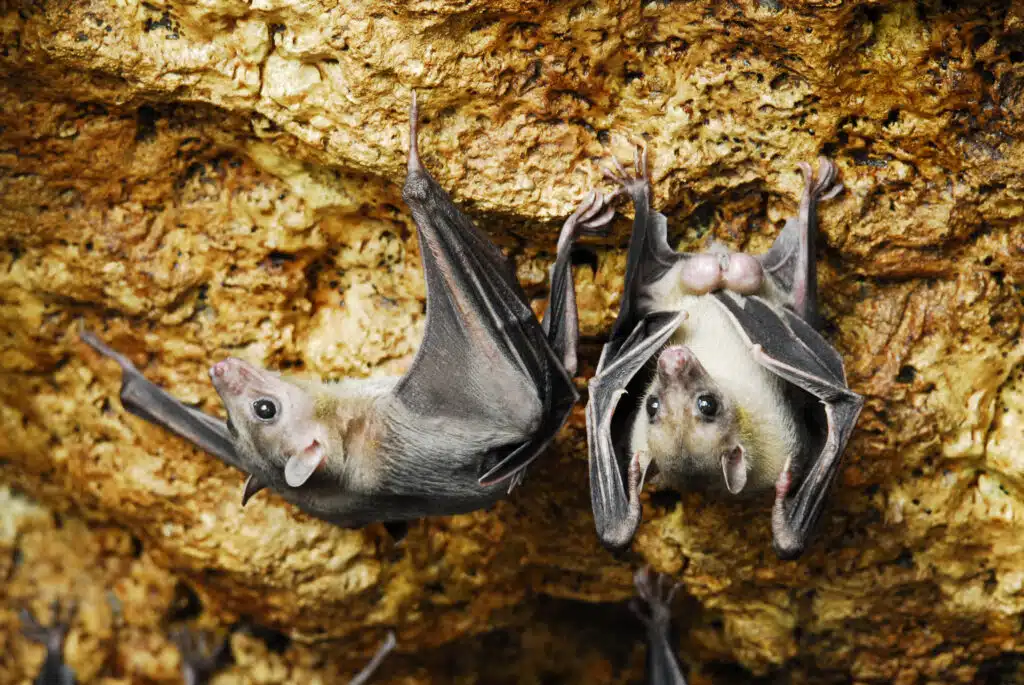
Old World Fruit Bats comprise more than one hundred and eighty species. These bats have large eyes and are widely distributed from Australia to Southeast Asia to Africa. They live in trees, caves, buildings, and rocks.
The most well-known old-world fruit bat is the flying fox, which lives on tropical islands, and can grow to 2.8 inches in body length with a 10-inch wingspan. They vary in color, with some having red or yellow stripes or spots.
They rely on their vision rather than relying on echolocation when avoiding obstacles.
2. Mouse-tailed Bats
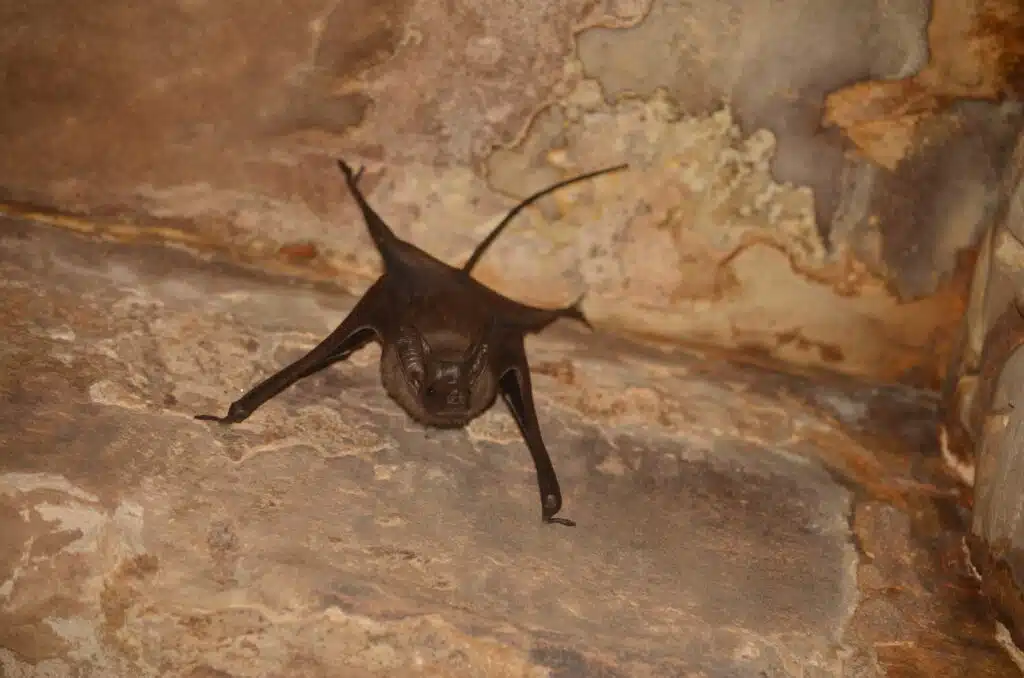
The Mouse-tailed Bat is an insectivorous bat that has six species within a single genus. They can be found from North America to Sumatra and Thailand, along with caves, houses, and arid regions. They have been sighted at the Egyptian pyramids.
They are small bats growing to 6cm in body length and weighing up to 14 grams. They have slender limbs with a long tail that is completely hairless. The tail is around the length of the body. They have a soft and short sandy-colored fur with big ears and large black eyes.
When food is scarce, these bats can live off their fat reserves.
They live in colonies, which comprise thousands of bats, some groups are male only, female only and there are also mixed groups.
They are fast fliers but get exhausted quickly, which means they also run on the ground.
3. Hog-nosed Bat
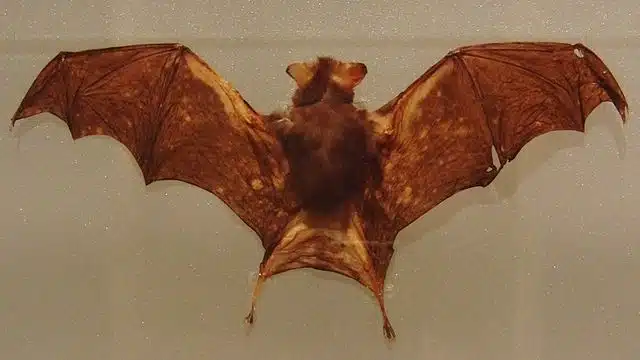
The Hog-nosed Bat is also known as the bumblebee bat and is a threatened species occurring in southeastern Myanmar and western Thailand where they live in limestone caves on the edge of rivers.
These are small bats and are considered the smallest mammal in the world.
They have a gray to red/brown colored coat and a snout that resembles the snout of a pig.
They average around one hundred bats in each colony, where they feed in the evenings and at dawn.
Those in Thailand are considered at risk of extinction, due to habitat degradation and roosting sites being disturbed.
These small bats grow to 1.3 inches (3.3cm) in body length and weigh up to 2 grams.
4. False-vampires
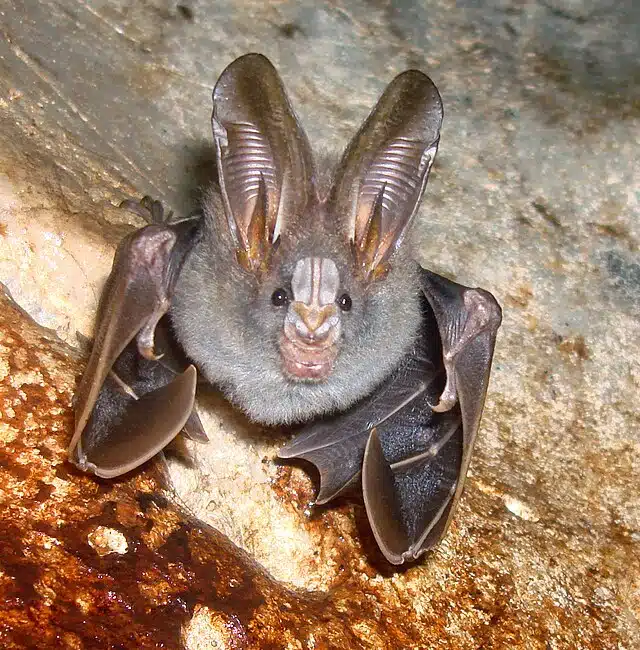
False-vampires bats do not feed on blood but are known to eat small vertebrates, including mice, lizards, and other bats.
They are large brown to gray colored bats that grow up to 14cm in body length. They have large rounded ears, a nose leaf, which is a flap of skin around the nostrils, and no tail.
They roost in hollow trees and caves, usually in pairs with their offspring. They range from Trinidad and Brazil to Peru and Southern Mexico, where they prefer tropical forests.
5. Trident Bats
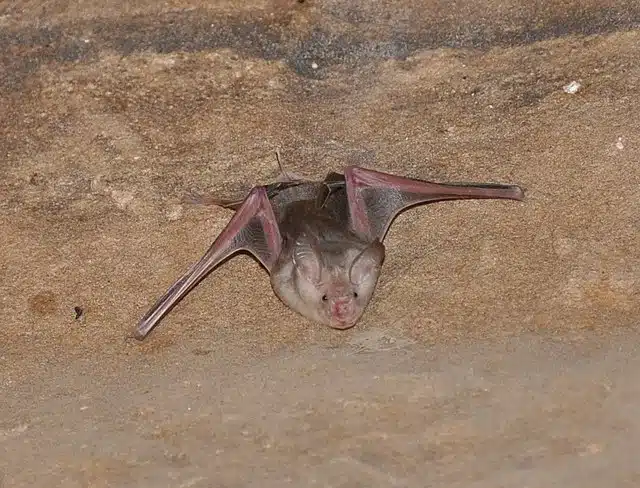
Trident Bats, also known as Trident Leaf-nosed Bats belong to the Hipposideridae family and can be found from Central Africa to the Middle East and the South and Central Asia. They live in subtropical or tropical dry forests, shrublands, savannas, and caves.
They can weigh up to 13 grams.
6. Old World Leaf-nosed Bats
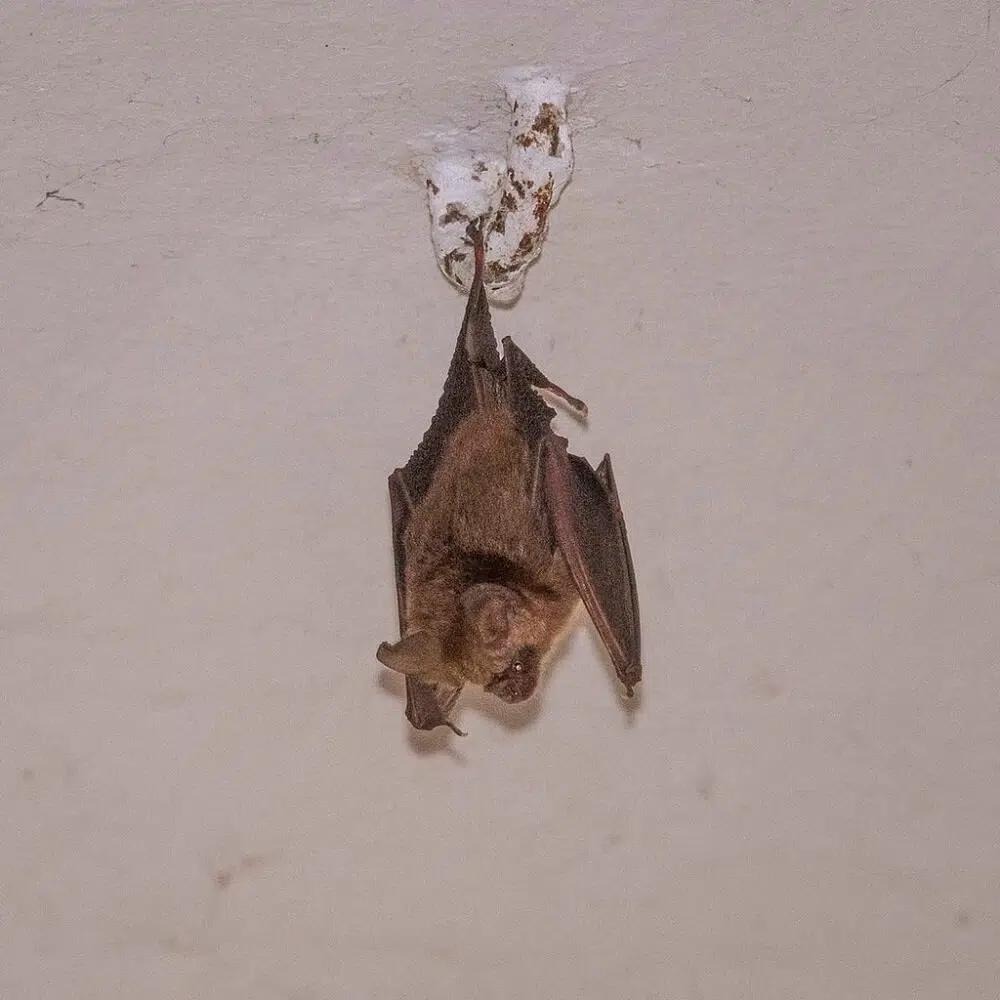
There are one hundred and sixty species of the Old World Leaf-nosed Bats, which are found from Argentina to the United States. They live in desert and forested areas.
They can be identified by the spearhead shape on their muzzle. They can range in color from dark to pale brown, gray, white and some are orange to red. They are medium-sized, growing to 3.5 inches (13.5cm) without their tail.
Their diets vary from insects to other mammals, while some feed on fruit, nectar, and pollen. They live in small groups in tree hollows, caves, buildings, and under bridges. This species includes the vampire bat.
7. Horseshoe Bats
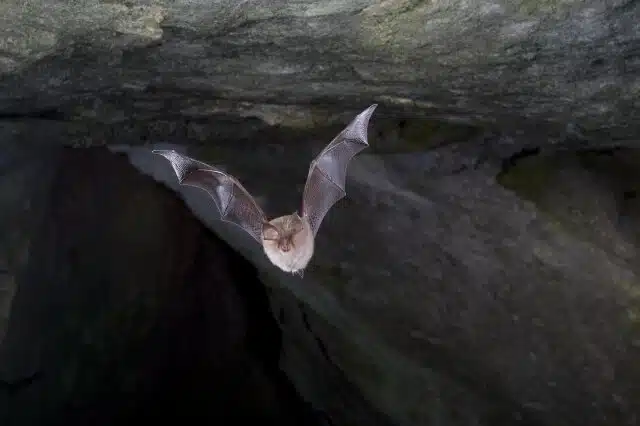
Horseshoe Bats belong to the Rhinolophidae family with around one hundred and sixty species. They are closely related to the Old World leaf-nosed bat. They are common in tropical and subtropical areas, including Asia, Europe, and Africa.
They grow to 3 inches (75mm) in body length, weighing up to 28 grams. Their fur is smooth and long and ranges from black or orange/red to red/brown.
These bats rely on echolocation to detect prey and obstacles. They hunt spiders and insects. Their lifespan is around seven years.
This bat has been involved in extensive research, especially regarding the SARS coronavirus. They are hunted as food in sub-Saharan Africa and Southeast Asia.
After the 2002 – 2004 SARS outbreak, numerous animals species were examined to see if they were a reservoir of the virus.
From 2003 to 2018, forty-seven SARS-related coronaviruses were detected in horseshoe bats. When the SARS-CoV2 virus outbreak occurred in 2019, it was discovered to be similar to the viruses already found in the horseshoe bat.
8. Slit-faced Bats
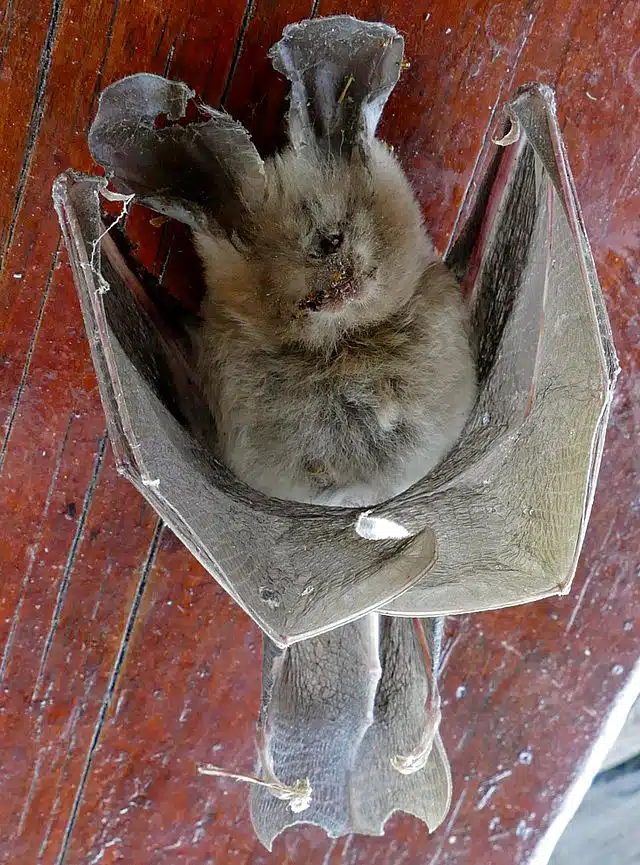
Slit-faced Bats, also known as hollow-faced bats are sixteen species in the Nycteridae family. These tropical bats can be found in Malaysia, Indonesia, and Africa.
They have a longitudinal hollow on their face with a nose leaf, a structure on the muzzle, that splits down the center. They grow to around 8cm in body length, excluding the tail, and can weigh up to thirty grams.
They are brown to gray in color with a T shape at the end of their tails, which supports the membrane, connecting to the thighs.
They prefer dark and humid shelters, such as tree hollows and caves, where they live on insects.
9. Sheath-tailed Bats
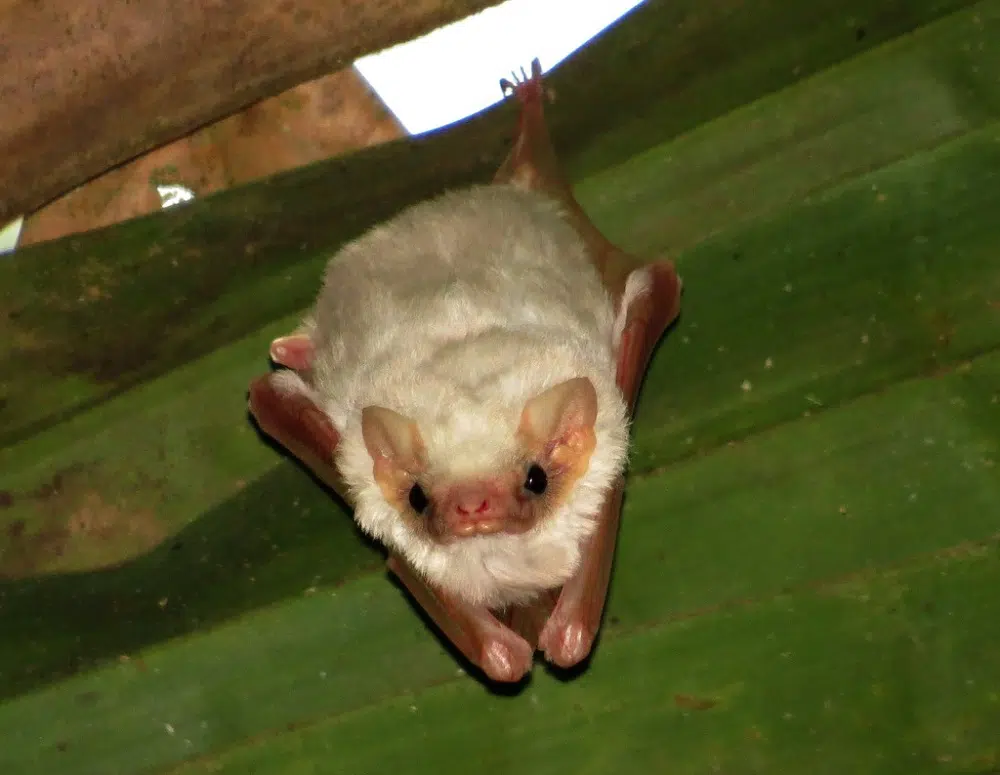
Sheath-tailed Bats belong to the Emballonuridae family. They are also known as sac-winged bats with around fifty species. Some of the species have glandular sacs on their wing membranes, which gave them their names.
They can be found in subtropical and tropical regions throughout the world growing to around 10cm without their tail and weighing up to thirty grams. They tend to shelter in open areas, such as shallow caves.
The sheath-tailed bats include the white striped bat in southern and central America, the ghost bats of the New World, and fast-flying bats from southern Asia, Australia, and Africa.
10. Madagascar Sucker-footed Bats
The Madagascar Sucker-footed Bat is also known as the Old World sucker foot bat and belongs to the Myzopodidae family and is native to Madagascar, especially in the forests on the Eastern side.
They are classified Vulnerable on the IUCN Red List of Threatened species, though they were reclassified as Least Concern in 2008.
This bat has small ups on their ankles and wrists, which enable them to attach themselves to smooth surfaces. They roost in the rolled leaves of the traveler tree. They control the cups using muscle contractions.
They do not sit upside down but are one of the very few bats that sit with their heads up. They feed on small moths and beetles and will only travel around 2km in search of food.
11. New Zealand Short-tailed Bats
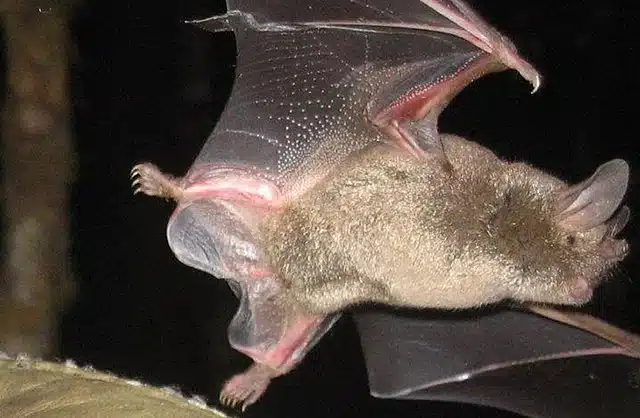
This bat is the only species in the Mystacinidae family and is native to New Zealand. It is often seen foraging on the forest floor, rather than hanging upside down or flying.
They are small, growing to around 7cm, excluding their tails with a 30cm wingspan, weighing 22 grams. They have large pointy ears and noticeable nostrils with a short tail, that is only around 12mm in length. Their snouts are cylindrical and long with whiskers and large nostrils.
They feed on nectar and have long tongues, which have hairs on the tip. They have talons n their claws and wings, which aid in climbing and crawling. Their thick fur can be mouse gray to dark brown.
They are most common on the North Island of New Zealand, living in forests. There are also some isolated populations from south Island.
These are nocturnal bats and roost during the day in a hollow tree. They come out at night and will forage the majority of the night, spending up to thirty percent of their time o the ground.
12. Disk-winged Bats
Disk-winged Bats belong to the Thyropteridae family and can be found from Central to Northern South America.
They have suction cups on their thumbs and the sole of their foot, which helps them cling to smooth surfaces. These small red to brown colored bats, grow to 5.2cm without their tails, weighing up to 4 grams.
They live in cohesive colonies where they roost in rolled-up leaves, sitting head up.
13. Smoky Bat and Thumbless Bat
Smoky Bat and Thumbless Bat can be found in the Central and Southern American tropics. These are two bats, the Amorphochilus Schnablil, which is the Smoky Bat, and the Furipterus Horrens, which is the Thumbless Bat.
They grow to around 5.8cm in body length, with long tails of around 36cm and they can weigh up to 5 grams. They range from brown to slate gray and have reduced thumbs, which are covered in a wing membrane.
They are very secretive and very rarely seen, therefore there is very little known about their habits.
14. Bulldog Bats
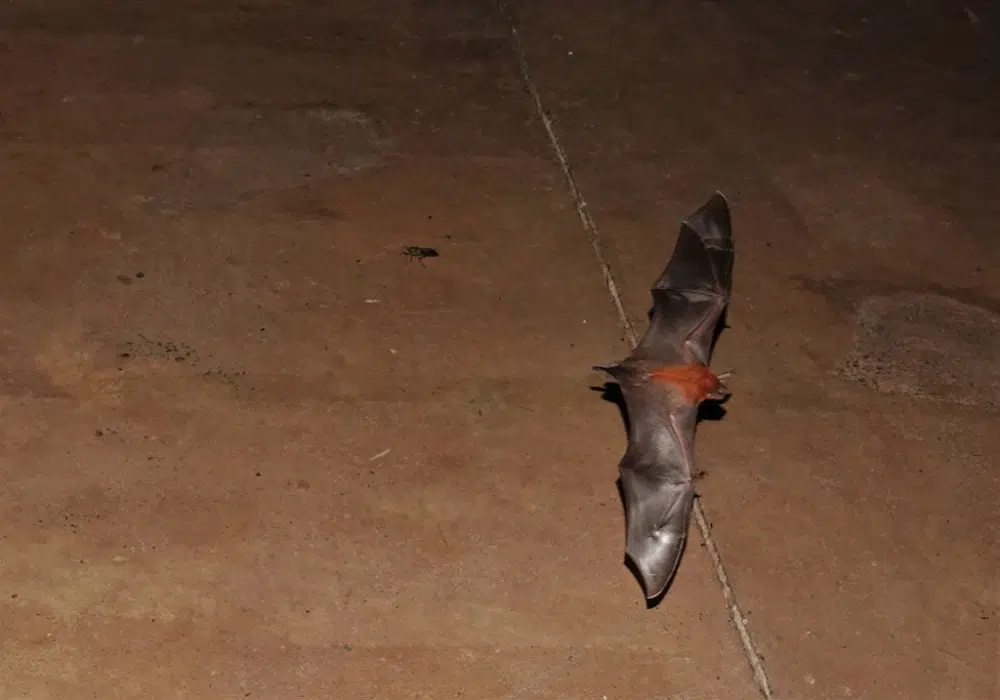
Bulldog Bats are also referred to as fishing bats. They can be found near water, ranging from Caribbean islands to Mexico and Argentina.
They roost in groups inside man-made homes, hollowed trees, and caves.
They have brown to orange-colored fur and can grow to 14cm in body length with long legs and large feet with strong claws. They have narrow and long wings with large funnel-shaped ears.
What makes these bats unusual is their cheek pouches that they have to store food. Their full lips are divided by a skin fold, with their cheek pouches making them look like bulldogs.
Some are insectivorous only, while others eat insects and fish. Using echolocation, they can identify ripples on the water’s surface. The greater bulldog bat will drag its curved talons in the water, helping them catch up to thirty small fish in one night.
15. Ghost-faced Bats
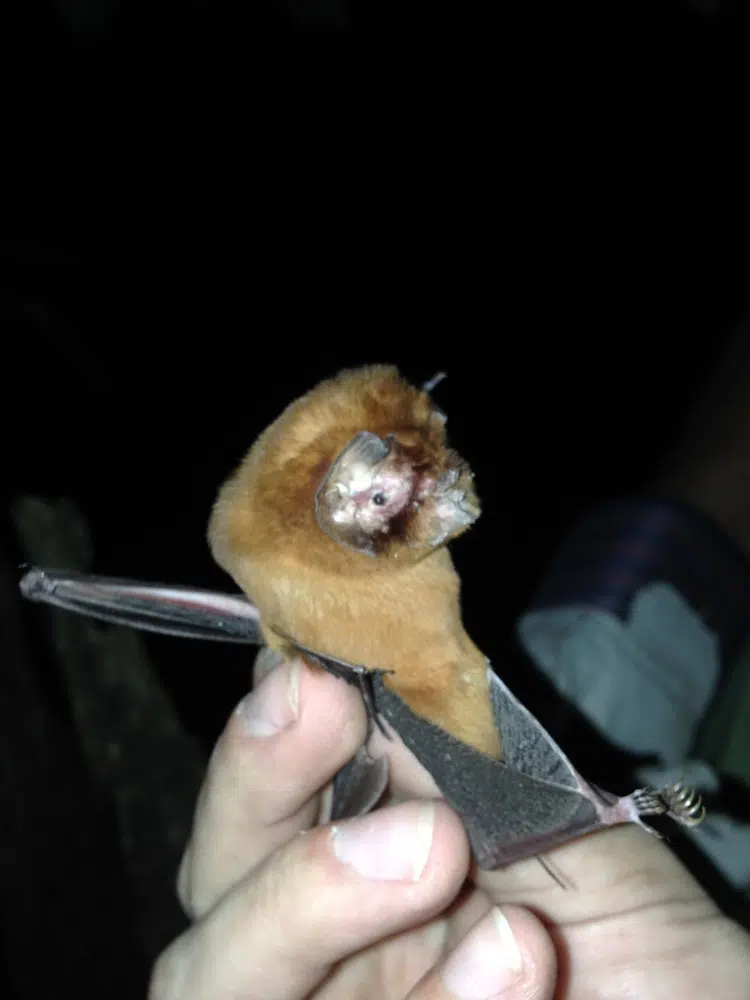
Ghost-faced Bats belong to the Mormoops genus and can be found in Columbia, Mexico, Peru, Ecuador, El Salvador, Honduras, Guatemala, Trinidad and Tobago, Venezuela, and Texas.
They hunt at night and rely on echolocation to identify food.
They have flaps of skin that hang from their face with a badly developed nose and large round ears, joining across the forehead, which has given this bat its name.
They are medium-sized bats that range from dark brown to red-brown color, they become more red-brown as they age. They molt during June and September, starting on the shoulders and spreading across the back.
They have high body temperatures, which makes them very sensitive to temperatures under 10ºC. They only survive in cold temperatures for a short period.
16. New World Leaf-nosed Bats
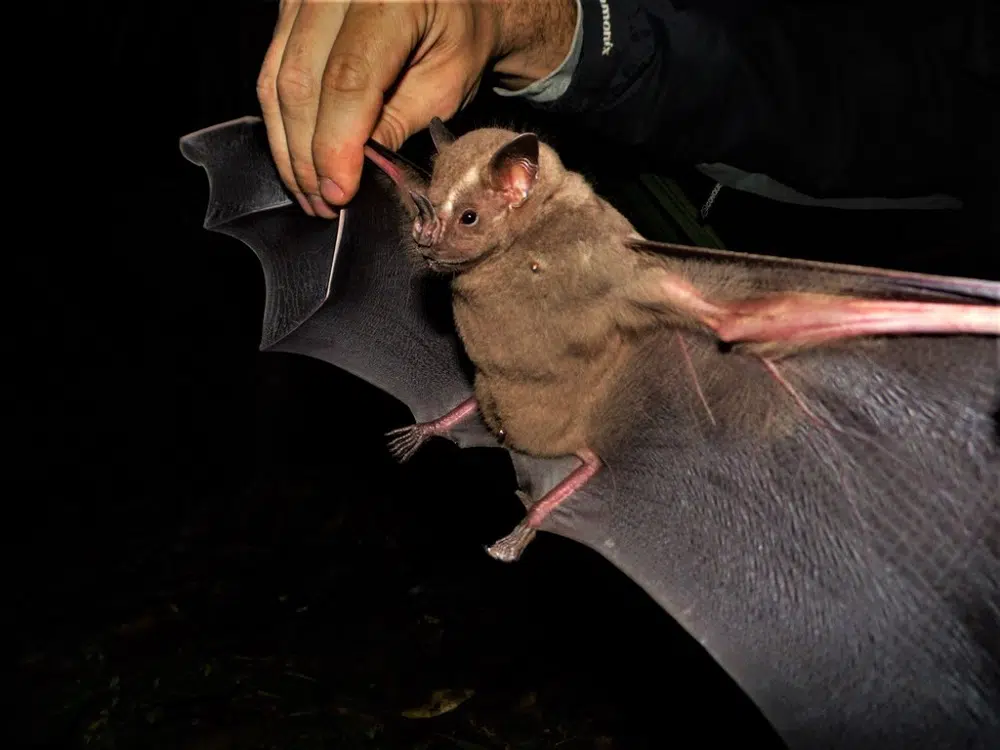
The New World Leaf-Nosed Bat can be found in South and southern North America. This is a very varied species, which are insectivores. Some do eat small birds, frogs, other bats, and blood.
They have a lance-shaped nose, which helps them with echolocation, which they do nasally.
These bats are usually brown, black, or gray, with five species known to be white. They can grow up to 13.5cm in body length, weighing up to 200 grams.
Some species are known to roost in small groups inside burrows, hollowed trees, and caves, while others roost in colonies of hundreds. They have triangular-shaped ears, that can be pointed or rounded.
17. Funnel-eared Bats
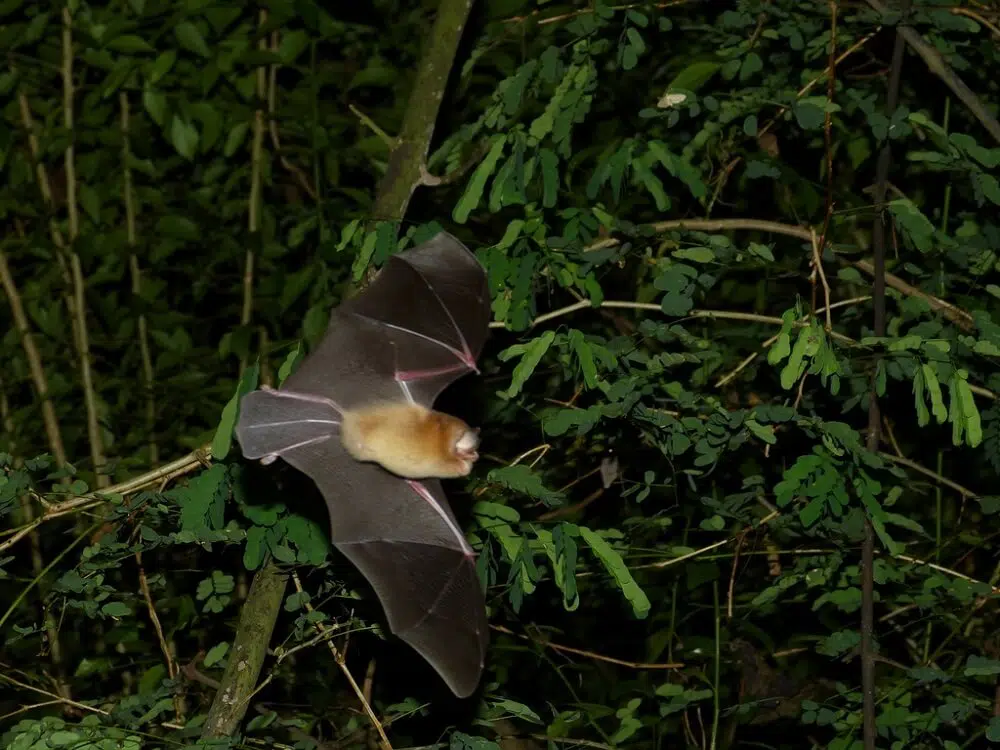
Funnel-eared Bats are eight species of small bat that can be found in northern South America, Central America, and the West Indies.
They have thick yellow, red or gray hair with a well-developed tail, large eyes, and a clumsy walk. These bats have slender wings and fragile legs. They have short thumbs, long tails, and an enclosed tail membrane.
They have a well developed “W” shaped tooth pattern with the third incisor being separated from the others
18. Free-tailed Bats
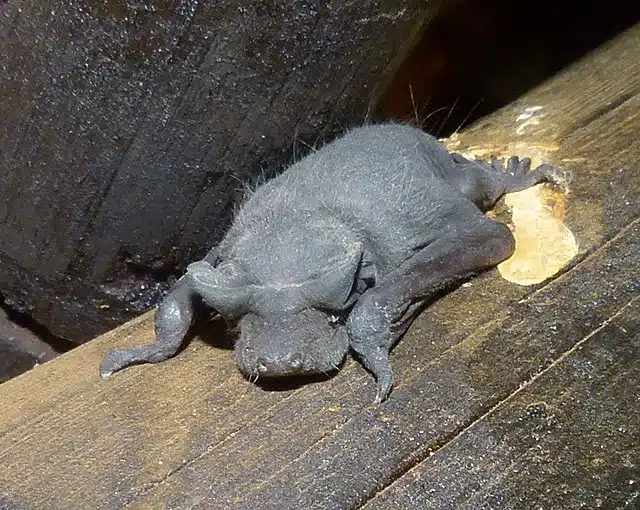
The Free-tailed Bat is a small dark bat that is able to fly fast, rather than flutter. While its back is dark in color, sometimes looking black, the belly and chest are a light gray, cream, or white.
They have two white to gray bands that run along the side of the body and a light band along the inner wing.
They have upright large ears. You can usually hear this bat squeaking just before dusk.
These bats roost in rocks, crevices, and under trees, along with under the roof of houses. They are known for forming large colonies in some South African regions.
They can be a nuisance due to the noise they make if large colonies move into a house roof.
They feed mostly on moths, plant-sucking bugs, and beetles, along with flies and mosquitoes.
19. Wing-gland Bats
Wing-gland Bats are known as the Angolan wing gland bat and can be found in Angola, South Africa, and Namibia. They prefer hot desert areas and have thickened glands o the wing.
They are large glands, which can be 3.5mm in length. It is most common in areas where they experience less than 100mm of rain each year.
20. Vesper Bats
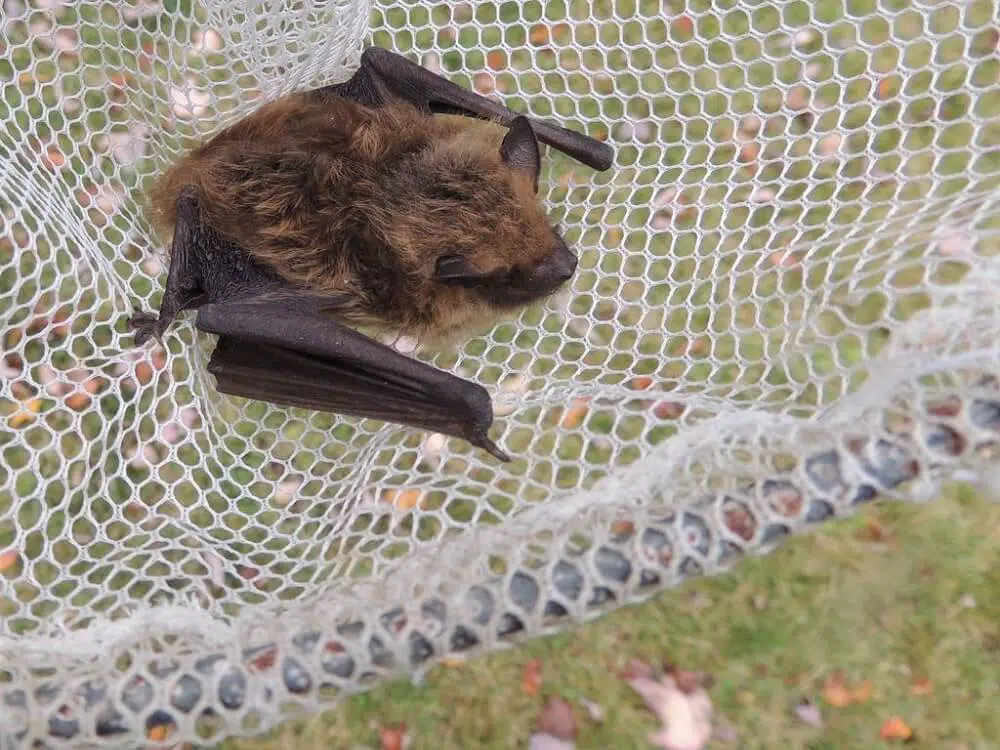
Vesper Bats are known as the evening bat, which is a large family of bats, made up of four hundred species.
They can be found throughout the world in tropical and temperature areas, where they live in deserts to tropical forests.
They have very well-developed tails, long wings, and large ears, with small eyes. They are black to gray, with some being red. They can grow up to 10cm in length and weigh up to 50 grams.
Most of the vesper bats feed on insects by catching their prey by the hind leg with their teeth. Some of the species, known as little brown bats, prey mostly on fish. They live in colonies, roosting in hollowed trees and caves.
Further Reading: